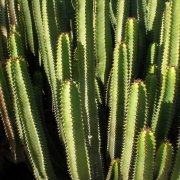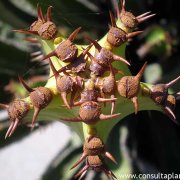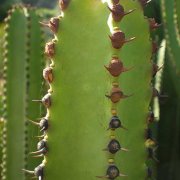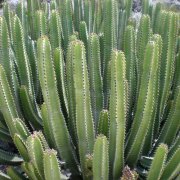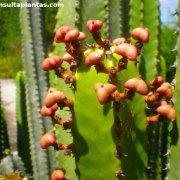Care of the succulent plant Euphorbia canariensis or Canary Island spurge |
|
The genus Euphorbia, family Euphorbiaceae, includes 2,000 species of succulents, trees, shrubs, and herbaceous plants of cosmopolitan distribution. Some species are: Euphorbia canariensis, Euphorbia viguieri, Euphorbia meloformis, Euphorbia lomelii, Euphorbia pulcherrima, Euphorbia bubalina, Euphorbia resinifera, Euphorbia candelabrum, Euphorbia milii, Euphorbia tithymaloides, Euphorbia regis-jubae, Euphorbia royleana, Euphorbia trigona, Euphorbia bivonae, Euphorbia characias, Euphorbia echinus, Euphorbia cotinifolia, Euphorbia rigida, Euphorbia handiensis, Euphorbia balsamifera, Euphorbia coerulescens, Euphorbia leucocephala. Common names: Canary Island spurge, Canary Candelaber Spurge, Hercules club. This species is native to the Canary Island. They are succulent plants branched from the base that reach 3 meters (9.84 feet) in height. The stems are straight, spiny and have 4-6 edges. They produce very unattractive little brown flowers. It blooms in summer. Canary Island spurge is used in Mediterranean coastal gardens on rockeries and slopes and as a houseplant in well-lit locations. Euphorbia canariensis prefers full sun exposure; they can grow in light shade. It needs heat and do not resists temperatures below 8 ºC (46.4 ºF). The soil can be a mixture, in equal parts, of peat and coarse sand. If it's grown in a pot, add a little garden substrate. In spring and summer water moderately waiting for the substrate to dry. In autumn water every 3 weeks and in winter once a month. Overwatering causes the roots to rot. Canary Candelaber Spurge propagates by seeds or by cuttings (in this case you have to watch out for fungal attack and irritating latex). |
Images of the succulent plant Euphorbia canariensis or Canary Island spurge |
Find plants
Euphorbia canariensis or Canary Island spurge | Care and Growing
© 2026 FavThemes
